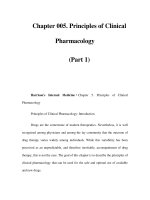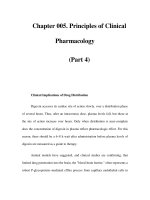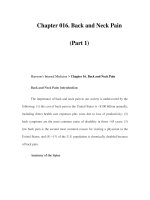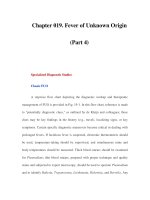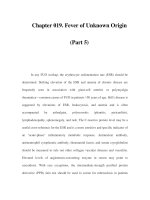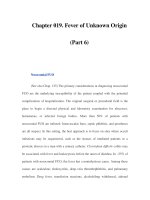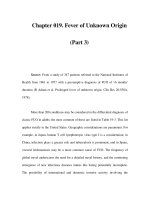Chapter 019. Fever of Unknown Origin (Part 1) ppsx
Bạn đang xem bản rút gọn của tài liệu. Xem và tải ngay bản đầy đủ của tài liệu tại đây (66 KB, 5 trang )
Chapter 019. Fever of Unknown Origin
(Part 1)
Harrison's Internal Medicine > Chapter 19. Fever of Unknown Origin
Definition and Classification
Fever of unknown origin (FUO) was defined by Petersdorf and Beeson in
1961 as (1) temperatures of >38.3°C (>101°F) on several occasions; (2) a duration
of fever of >3 weeks; and (3) failure to reach a diagnosis despite 1 week of
inpatient investigation. While this classification has stood for more than 30 years,
Durack and Street have proposed a new system for classification of FUO: (1)
classic FUO; (2) nosocomial FUO; (3) neutropenic FUO; and (4) FUO associated
with HIV infection.
Classic FUO corresponds closely to the earlier definition of FUO, differing
only with regard to the prior requirement for 1 week's study in the hospital. The
newer definition is broader, stipulating three outpatient visits or 3 days in the
hospital without elucidation of a cause or 1 week of "intelligent and invasive"
ambulatory investigation. In nosocomial FUO, a temperature of ≥38.3°C (≥101°F)
develops on several occasions in a hospitalized patient who is receiving acute care
and in whom infection was not manifest or incubating on admission. Three days of
investigation, including at least 2 days' incubation of cultures, is the minimum
requirement for this diagnosis. Neutropenic FUO is defined as a temperature of
≥38.3°C (≥101°F) on several occasions in a patient whose neutrophil count is
<500/µL or is expected to fall to that level in 1–2 days. The diagnosis of
neutropenic FUO is invoked if a specific cause is not identified after 3 days of
investigation, including at least 2 days' incubation of cultures. HIV-associated
FUO is defined by a temperature of ≥38.3°C (≥101°F) on several occasions over a
period of >4 weeks for outpatients or >3 days for hospitalized patients with HIV
infection. This diagnosis is invoked if appropriate investigation over 3 days,
including 2 days' incubation of cultures, reveals no source.
Adoption of these categories of FUO in the literature has allowed a more
rational compilation of data regarding these disparate groups. In the remainder of
this chapter, the discussion will focus on classic FUO in the adult unless otherwise
specified.
Causes of Classic FUO
Table 19-1 summarizes the findings of several large studies of FUO carried
out since the advent of the antibiotic era, including a prospective study of 167
adult patients with FUO encompassing all eight university hospitals in the
Netherlands and using a standardized protocol in which the first author reviewed
every patient. Coincident with the widespread use of antibiotics, increasingly
useful diagnostic technologies—both noninvasive and invasive—have been
developed. Newer studies reflect not only changing patterns of disease but also the
impact of diagnostic techniques that make it possible to eliminate many patients
with specific illness from the FUO category. The ubiquitous use of potent broad-
spectrum antibiotics may have decreased the number of infections causing FUO.
The wide availability of ultrasonography, CT, MRI, radionuclide scanning, and
positron emission tomography (PET) scanning has enhanced the detection of
localized infections and of occult neoplasms and lymphomas in patients previously
thought to have FUO. Likewise, the widespread availability of highly specific and
sensitive immunologic testing has reduced the number of undetected cases of
systemic lupus erythematosus and other autoimmune diseases.
Table 19-1 Classic FUO in Adults
A
uthors
(Year of
Publicati
Y
ears
of
Study
o. of
Cases
In
fections
(%)
Ne
oplasms
(%)
Noni
nfectious
Inflammat
ory
Diseases
Misc
ellaneous
Causes (%)
Und
iagnosed
Causes
(%)
on) (%)
Pe
tersdorf
and
Beeson
(1961)
1
952–
1957
00
36
19 19
a
19
a
7
La
rson and
Featherst
one
(1982)
1
970–
1980
05
30
31 16
a
11a 12
K
nockaert
and
Vanneste
(1992)
1
980–
1989
99
22
.5
7 23
a
21.5
a
25.5
de
1
26
12. 24 8 30
Kleijn et
al. (1997,
Part I)
992–
1994
67 5
a
Authors' raw data retabulated to conform to altered diagnostic categories.
Source: Modified from de Kleijn et al., 1997 (Part I).
